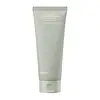What's inside
What's inside
 Key Ingredients
Key Ingredients

 Benefits
Benefits

 Concerns
Concerns

 Ingredients Side-by-side
Ingredients Side-by-side

Water
Skin ConditioningMyristic Acid
CleansingGlycerin
HumectantPotassium Hydroxide
BufferingPropylene Glycol
HumectantLauric Acid
CleansingPalmitic Acid
EmollientStearic Acid
CleansingPEG-75
HumectantGlyceryl Stearate
EmollientPEG-100 Stearate
Salicylic Acid
MaskingParfum
MaskingPoloxamer 184
EmulsifyingPhenoxyethanol
PreservativeCentella Asiatica Extract
CleansingFicus Carica Fruit Extract
HumectantButylene Glycol
HumectantDisodium EDTA
Hydrogenated Lecithin
Emulsifying1,2-Hexanediol
Skin ConditioningAmaranthus Caudatus Seed Extract
Skin ConditioningUlmus Davidiana Root Extract
Skin ConditioningUndaria Pinnatifida Extract
Skin ConditioningCeramide NP
Skin ConditioningCanadian Colloidal Clay
Skin ConditioningMoroccan Lava Clay
AbrasiveSpirulina Platensis Extract
Skin ProtectingOyster Shell Extract
Sea Silt Extract
Skin ConditioningSodium Bicarbonate
AbrasiveWater, Myristic Acid, Glycerin, Potassium Hydroxide, Propylene Glycol, Lauric Acid, Palmitic Acid, Stearic Acid, PEG-75, Glyceryl Stearate, PEG-100 Stearate, Salicylic Acid, Parfum, Poloxamer 184, Phenoxyethanol, Centella Asiatica Extract, Ficus Carica Fruit Extract, Butylene Glycol, Disodium EDTA, Hydrogenated Lecithin, 1,2-Hexanediol, Amaranthus Caudatus Seed Extract, Ulmus Davidiana Root Extract, Undaria Pinnatifida Extract, Ceramide NP, Canadian Colloidal Clay, Moroccan Lava Clay, Spirulina Platensis Extract, Oyster Shell Extract, Sea Silt Extract, Sodium Bicarbonate
Water
Skin ConditioningCoco-Betaine
CleansingDisodium Cocoamphodiacetate
CleansingGlycerin
HumectantSodium Chloride
MaskingPotassium Cocoyl Glycinate
Acrylates Copolymer
1,2-Hexanediol
Skin ConditioningPolyglyceryl-10 Laurate
Skin ConditioningCeramide As
Skin ConditioningCeramide AP
Skin ConditioningCeramide EOP
Skin ConditioningCeramide NP
Skin ConditioningCeramide Ns
Skin ConditioningAscorbic Acid
AntioxidantPhytosphingosine
Skin ConditioningMyrothamnus Flabellifolia Leaf/Stem Extract
HumectantHydrogenated Lecithin
EmulsifyingCetearyl Alcohol
EmollientStearic Acid
CleansingPropanediol
SolventXanthan Gum
EmulsifyingEthylhexylglycerin
Skin ConditioningDisodium EDTA
Hexylene Glycol
EmulsifyingCholesterol
EmollientCitric Acid
BufferingBetaine
HumectantSodium Citrate
BufferingWater, Coco-Betaine, Disodium Cocoamphodiacetate, Glycerin, Sodium Chloride, Potassium Cocoyl Glycinate, Acrylates Copolymer, 1,2-Hexanediol, Polyglyceryl-10 Laurate, Ceramide As, Ceramide AP, Ceramide EOP, Ceramide NP, Ceramide Ns, Ascorbic Acid, Phytosphingosine, Myrothamnus Flabellifolia Leaf/Stem Extract, Hydrogenated Lecithin, Cetearyl Alcohol, Stearic Acid, Propanediol, Xanthan Gum, Ethylhexylglycerin, Disodium EDTA, Hexylene Glycol, Cholesterol, Citric Acid, Betaine, Sodium Citrate
 Reviews
Reviews

Ingredients Explained
These ingredients are found in both products.
Ingredients higher up in an ingredient list are typically present in a larger amount.
1,2-Hexanediol is a synthetic liquid and another multi-functional powerhouse.
It is a:
- Humectant, drawing moisture into the skin
- Emollient, helping to soften skin
- Solvent, dispersing and stabilizing formulas
- Preservative booster, enhancing the antimicrobial activity of other preservatives
Ceramide NP is a type of ceramide.
Ceramides are intercellular lipids naturally found in our skin that bonds dead skin cells together to create a barrier. They are known for their ability to hold water and thus are a great ingredient for dry skin.
Ceramides are an important building block for our skin barrier. A stronger barrier helps the skin look more firm and hydrated. By bolstering the skin ceramides act as a barrier against irritating ingredients. This can help with inflammation as well.
If you would like to eat ceramides, sweet potatoes contain a small amount.
Read more about other common types of ceramides here:
Ceramide AP
Ceramide EOP
Disodium EDTA plays a role in making products more stable by aiding other preservatives.
It is a chelating agent, meaning it neutralizes metal ions that may be found in a product.
Disodium EDTA is a salt of edetic acid and is found to be safe in cosmetic ingredients.
Learn more about Disodium EDTAGlycerin is already naturally found in your skin. It helps moisturize and protect your skin.
A study from 2016 found glycerin to be more effective as a humectant than AHAs and hyaluronic acid.
As a humectant, it helps the skin stay hydrated by pulling moisture to your skin. The low molecular weight of glycerin allows it to pull moisture into the deeper layers of your skin.
Hydrated skin improves your skin barrier; Your skin barrier helps protect against irritants and bacteria.
Glycerin has also been found to have antimicrobial and antiviral properties. Due to these properties, glycerin is often used in wound and burn treatments.
In cosmetics, glycerin is usually derived from plants such as soybean or palm. However, it can also be sourced from animals, such as tallow or animal fat.
This ingredient is organic, colorless, odorless, and non-toxic.
Glycerin is the name for this ingredient in American English. British English uses Glycerol/Glycerine.
Learn more about GlycerinHydrogenated Lecithin is created from the hydrogenation of lecithin (a group of phospholipids). Hydrogenation is a chemical reaction between hydrogen and another element.
This ingredient is an emollient and emulsifier. As an emollient, it helps soften skin by trapping moisture within. As an emulsifier, it prevents oil and water ingredients from separating.
Stearic Acid is a fatty acid. It is an emollient, emulsifier, and texture enhancer.
As an emollient, stearic acid helps soften skin. It aids the skin's protective barrier by preventing water loss. It also provides a gentle cleansing effect without stripping away natural oils.
Stearic acid may also be used to enhance the texture of products. It can add volume and stabilize ingredients such as water and oil. This can help water and oil ingredients from separating.
Sources of stearic acid include animal or vegetable fats/oils such as coconut or shea. It can be naturally found in butter, cocoa butter, shea butter, vegetable fats, and animal tallow.
This ingredient may not be Malassezia folliculitis, or fungal-acne safe.
Learn more about Stearic AcidWater. It's the most common cosmetic ingredient of all. You'll usually see it at the top of ingredient lists, meaning that it makes up the largest part of the product.
So why is it so popular? Water most often acts as a solvent - this means that it helps dissolve other ingredients into the formulation.
You'll also recognize water as that liquid we all need to stay alive. If you see this, drink a glass of water. Stay hydrated!
Learn more about Water